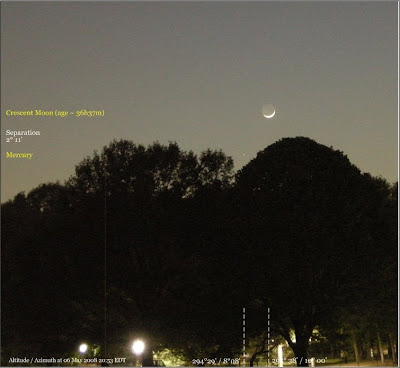May 2008 observations from Central Park

This month there were many opportunities at the Top of the Lawn where more than a hundred people would get views of our sky. Mercury, Mars, Saturn, and our Moon have been the dominant objects. Diversions to nearby doubles and bright deep sky objects offered variety to the pedestrians' visual palate.
Saturn continues to be the dominant object that stirs the general public. These past days, one looks high in the manhattan-southwest sky to see an obvious pair of stars; the upper, brighter "star" is Saturn. The star below and west of Saturn is the alpha star of Leo, Regulus. Most are just as surprised that one can see Saturn (or anything else for that matter) in the city sky without a telescope , as well as see the rings and moons in the telescope.
A Darker View describes people's reaction to observing Saturn. Anyone who has shared the eyepiece to offer peeks at Saturn will agree that there is a personal joy that you touched someone; their reaction is the immediate satisfaction. The reward actually belongs to that observer.
Mars has been another delight. Easy to locate as lone, reddish star, Mars sits almost halfway between Castor/Pollux pair and Saturn/Regulus pair. The red planet just passed through the heart of Cancer offering a splendid view of our neighbor superposed on M44, an open cluster some 577 light years distant. (On a separate observing session, I observed the motion of Mars against the background stars, an exciting first!)
Many who passed last night spoke of the Phoenix landing on the surface of Mars. (Bravo to the talent that makes these missions successful!) Through cirrus and alto stratus clouds we observed Mars at one side of the 2° field of view and the entire open cluster M44 on the other side. Since Mars is small and far from Earth in its orbit around the Sun, it appears as a small reddish disk at magnifications 63x & 12ox. Lately, I show to passersby a map of Mars on the Palm T3 using Brian Tung's Mars Map.
Placing the scope a little east of TotL proper, our western horizon improves where Mercury sets with Taurus. The tree line from this perspective offers convenient landmarks that are easy to describe and guide the pedestrians to locate Mercury relative to the crowns of the trees. Many saw Mercury for their time and just as many have forgotten - or didn't realize - that Messenger mission flew by Mercury earlier this year on its first pass of three before an orbital insertion around Mercury in 2011.
Earlier in the month many of us watched the beautiful crescent Moon set with Mercury attending by her side. I wonder how many would have noticed this spectacle if a telescope set up on the sidewalk didn't prompt their curiousity an ddesire to know what's up in the sky.
 Look up after midnight to see the waxing moon rise. Recently, Jupiter, in Sagittarius, rose above our ciyy skyline about 8° west northwest of the Moon.
Look up after midnight to see the waxing moon rise. Recently, Jupiter, in Sagittarius, rose above our ciyy skyline about 8° west northwest of the Moon.If it's a clear weekend night, stop by the Great Lawn to observe these and other fantastic objects.














